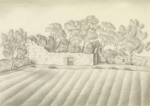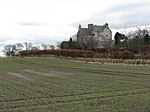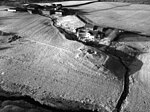List of castles in West Lothian
There are a number of castles in West Lothian, Scotland. They range from medieval mottes, through tower houses and Renaissance laird's houses, to relatively modern castellated mansions.
Many of the earliest castles are long since abandoned, and are either visible as earthworks, or only known from historical record. Later medieval and early modern buildings are often ruined, though several have been restored from a ruinous condition. Among those which have been continuously occupied are Bridge, Ochiltree and House of the Binns. Also within West Lothian is the ruined royal palace of Linlithgow, built on the site of an earlier fortification, but elaborated as one of the principal royal residences of the Scottish monarchy.
The council area of West Lothian lies to the west of Edinburgh, south of the Firth of Forth. The area differs from the historical county of West Lothian (Linlithgowshire): it includes castles which were formerly in Midlothian (e.g. Cairns Castle), and excludes others which were in West Lothian but now lie in Edinburgh (e.g. Dundas Castle).
List of castles
| Name | Image | Location | Type | Date | Notes |
|---|---|---|---|---|---|
| Abercorn Castle | Abercorn NT 0828 7928 55°59′52″N 3°28′20″W / 55.9977°N 3.4721°W |
Unknown | Unknown | William de Avenel held the lands of Abercorn in the 12th century, and the castle was later a stronghold of the Black Douglases. In 1455 James II moved to curb the power of the Douglases, capturing several of their castles, and on 18 April Abercorn Castle was destroyed following a siege. The site of the castle is within the grounds of Hopetoun House and was excavated in the 1960s. What was thought to be a motte was revealed as a later mound, covering the remains of 15th- and 16th-century buildings.[1] | |
| Baads Castle | West Calder NT 005 614 55°50′10″N 3°35′20″W / 55.836°N 3.589°W |
Unknown | 1588 | Baads Castle was probably built in 1588. It was a property of the Douglas family, and burned down in 1736. The precise location is uncertain.[2][3] | |
| Bathgate Castle | Bathgate NS 9807 6805 55°53′41″N 3°37′53″W / 55.8948°N 3.6314°W |
Motte | Unknown | Walter, High Steward of Scotland, received the barony and castle of Bathgate as part of the dowry assigned to his bride Marjorie Bruce, daughter of Robert the Bruce, in 1314. Walter died there in 1327, and the castle may have been little used afterwards. The only traces are a mound ringed by a double ditch, located within a golf course.[4] | |
| Bridge Castle | 
|
Westfield NS 9435 7095 55°55′12″N 3°41′31″W / 55.920°N 3.692°W |
Tower house | Unknown | Constructed as a tower house in the 16th century, Bridge was the property of William Livingstone, 6th Lord Livingston, from 1578 and stayed in the family until their attainder in 1715. It was subsequently enlarged, then remodelled by Brown and Wardrop in 1886. In use as a hotel in the 1970s, it is now subdivided as apartments.[5][6] |
| Cairns Castle | 
|
Harperrig Reservoir NT 0904 6051 55°49′45″N 3°27′14″W / 55.8292°N 3.4538°W |
Tower house | 1440 | The remains of the 15th-century castle of the Crichton family stand beside Harperrig Reservoir in the Pentland Hills. Cairns was built for Sir George Crichton (d.1454), who served as Lord High Admiral of Scotland and was created Earl of Caithness in 1452.[7] Originally an L-plan tower house, it comprised a main tower with a smaller stair tower to the south-west. The ruins stand around 9 metres (30 ft) high.[8][9] |
| Carribber Castle or Rob Gibb's Castle | 
|
Avon Valley, Linlithgow NS 9657 7516 55°57′30″N 3°39′29″W / 55.9583°N 3.6581°W |
Manor house | Unknown | In 1553 Robert Gib of Carribers was a baillie at the port of Newhaven near Edinburgh. Carribber Castle is the remains of a 16th-century manor house, and is unlikely to have been fortified due to its thin walls (less than 1 metre (3 ft 3 in) thick). Relatively little remains above ground, though the outlines of a courtyard and surrounding buildings can be traced, overlooking the steep Carribber Glen.[10] |
| Couston Castle | North Couston, Bathgate NS 9558 7115 55°55′20″N 3°40′21″W / 55.9221°N 3.6724°W |
Tower house | Unknown | Built at some point between the 15th and 17th centuries, Couston was an L-plan structure, owned by the Sandilands family. By the early 20th century it had been reduced to a fragmentary ruin adjacent to a farmyard. The remaining structure was declared dangerous in 2006 and was demolished. The only artifact recovered during demolition was a piece of Medieval redware pottery within the mortar.[11] | |
| Duntarvie Castle | 
|
Winchburgh NT 0905 7648 55°58′21″N 3°27′32″W / 55.9726°N 3.4588°W |
Renaissance house | 1590 | James Durham was granted the Duntarvie estate in 1588, and the house was built afterward. A long, symmetrical house of the Scots Renaissance style, it later became part of the Hopetoun Estate. Roofless in the 1920s, restoration of the house began in 1995, though still incomplete in 2014.[12] |
| House of the Binns | 
|
Blackness NT 0508 7857 55°59′27″N 3°31′23″W / 55.9907°N 3.5231°W |
Castellated house | 1621–1630 | Site of a castle since the 15th century, The Binns was purchased by the Dalyell family in 1612 and rebuilt in the 1620s. The original building was extended several times, and remodelled entirely in the early 19th century.[13] Notable residents include 17th-century general Tam Dalyell of the Binns, and the current occupant is former Labour MP Tam Dalyell. The house and parks have been managed by the National Trust for Scotland since 1944.[14] |
| Illieston | 
|
Almond Valley, near Broxburn NT 1008 6998 55°54′52″N 3°26′24″W / 55.9145°N 3.4401°W |
Manor house | Unknown | The Stewart kings James II and James IV are said to have had a hunting lodge at Illieston. The present three-storey house is probably of late 16th century or early 17th century date. It was purchased by John Ellis, an advocate in Edinburgh, around 1663. He added a Renaissance gateway inscribed with his initials and the date 1665. Later it became the property of the Earl of Hopetoun. It is now a private house.[15][16] |
| Linlithgow Palace | 
|
Linlithgow NT 0019 7732 55°58′43″N 3°36′03″W / 55.9785°N 3.6009°W |
Royal palace | 1424 onwards | A fortification known as The Peel was built here by Edward I of England in 1302. Rebuilt as a palace in 1424 by James I of Scotland and elaborated into a grand quadrangular complex by subsequent monarchs. One of the principal royal residences in Scotland until the accession of James VI to the throne of England in 1603.[17] Afterwards it was seldom used, and the palace burned down while occupied by the Duke of Cumberland in 1746. Now in the care of Historic Environment Scotland.[18] |
| Lochcote Castle | 
|
Torphichen NS 9769 7396 55°56′52″N 3°38′24″W / 55.9479°N 3.6399°W |
Unknown | Unknown | Lochcote Castle comprises the remains of an angle tower, which were subsequently re-used as a doocot. The castle was replaced by Lochcote House, which was itself demolished in the 19th century.[19] |
| Midhope Castle | 
|
Abercorn NT 0728 7868 55°59′32″N 3°29′16″W / 55.9921°N 3.4879°W |
Tower house | Built as a tower house in the late 16th century when it belonged to the Drummond family. Midhope was rebuilt and extended by John Hope when he acquired it in 1678, and is now part of the Hopetoun Estate. In 1926 the building was subdivided for apartments, but was afterwards empty. The interior contains plasterwork ceilings, though wall paintings were destroyed during consolidation work in the 1980s.[20] | |
| Murieston Castle | Murieston NT 0501 6349 55°51′19″N 3°31′08″W / 55.8552°N 3.5189°W |
Folly | Unknown | Built as a tower house in the 16th century, Murieston was rebuilt as a folly in 1824, and few of its original features now remain. The two-storey structure now stands within a farmstead.[21] | |
| Niddry Castle | 
|
Winchburgh NT 0952 7437 55°57′14″N 3°27′02″W / 55.9538°N 3.4505°W |
Tower house | Unknown | Niddry was a seat of the Seton family, and was constructed in the 15th-16th century. The 7th Lord Seton was one of the principal supporters of Mary, Queen of Scots, whom he brought here after her escape from Loch Leven. In the 17th century the tower was extended upwards, and it passed to the Hopes of Hopetoun around 1680. The ruined tower was subject to archaeological investigation in the 1980s, and was subsequently restored, though without the 17th-century upper floor.[22] |
| Ochiltree Castle | 
|
Bridgend NT 0326 7476 55°57′22″N 3°33′03″W / 55.9561°N 3.5509°W |
Laird's house | Unknown | Ochiltree was held by the Stirling family of Keir, and the house bears the initials of Sir Alexander Stirling and his wife Dame Grizel. It was built in the later 16th or early 17th century in the Scottish Renaissance style, and subsequently altered in the later 17th century.[23] It is described as a "very fine example" of its type.[24] |
| Ogilface Castle | 
|
Woodend, Armadale NS 9270 6901 55°54′08″N 3°43′03″W / 55.9022°N 3.7176°W |
Tower house | Unknown | Ogilface was granted to the de Bosco family by David I in the 12th century.[25] It later passed to the Earl of Linlithgow, and is said to have been used by the Covenanters during the religious conflicts of the 17th century.[26] Now entirely ruined, archaeological surveys indicate a tower similar to Cramond Tower once stood on the site.[25] |
| Peel of Livingston | Livingston NT 0398 6758 55°53′30″N 3°32′12″W / 55.8918°N 3.5368°W |
Unknown | Unknown | The Peel of Livingston was established in the 14th century, and housed an English garrison in the Wars of Scottish Independence. In the 18th century the remains of earthwork defences could be observed, possibly a homestead moat, with a later house built inside. By the middle of the 19th century these remains had been removed, and the area is now built up as part of the new town of Livingston. Excavations in the 1960s failed to uncover significant remains, and the precise site is now uncertain.[27] | |
| Pumpherston Castle | Pumpherston NT 0755 6865 55°54′08″N 3°28′48″W / 55.9021°N 3.4801°W |
Unknown | Unknown | Although it may have once been a substantial building, nothing now remains of Pumpherston Castle, the ruins of which were removed in the late 18th century.[28] It was the seat of a branch of the Douglas family from 1489 to the close of the 17th century.[29] | |
| Staneyhill Tower | 
|
Hopetoun NT 0916 7851 55°59′27″N 3°27′28″W / 55.9909°N 3.4577°W |
Tower house | Unknown | Staneyhill was built in the 17th century for the Sharp family: the architect may have been Sir James Murray of Kilbaberton.[30] William Sharp of Staneyhill was the brother of James Sharp, Archbishop of St Andrews, who was murdered by Covenanters in 1679.[31] Only the stair tower now remains standing, with ruined lower walls of the house.[30] |
| Strathbrock Castle | Uphall NT 0575 7164 55°55′43″N 3°30′36″W / 55.9286°N 3.5099°W |
Motte | Unknown | The lands of Strathbrock were given to Freskyn, a Flemish nobleman, by David I in the 12th century. By the early 15th century it was in the hands of the Douglas family, and in 1524 the rector of Strathbrock Church lived there. The castle may have been a motte, with later stone buildings, and its remains were visible in the early 18th century. The area, to the south of Uphall's Main Street, is now built up.[32] | |
| Tartraven Castle | Castlepark, Torphichen NT 0045 7264 55°56′11″N 3°35′42″W / 55.9365°N 3.5951°W |
Unknown | Unknown | Tartraven may have been a small castle or manor, and belonged to a family called Ross. The ruins were still visible in the early 19th century, but nothing now remains. The site is adjacent to Castlepark Farm, which may incorporate stone from the castle.[33] |
See also
Notes
- ^ "Abercorn Castle". Canmore. Royal Commission on the Ancient and Historical Monuments of Scotland. Retrieved 10 February 2014.
- ^ "Baads Castle". Canmore. Royal Commission on the Ancient and Historical Monuments of Scotland. Retrieved 11 February 2014.
- ^ "Douglas of Baads". The Douglas Archives. Retrieved 11 February 2014.
- ^ "Bathgate Castle". Canmore. Royal Commission on the Ancient and Historical Monuments of Scotland. Retrieved 10 February 2014.
- ^ "Bridge Castle". Canmore. Royal Commission on the Ancient and Historical Monuments of Scotland. Retrieved 7 February 2014.
- ^ "4 Bridge Castle House, Property Details". House Spotters. Archived from the original on 11 February 2014.
- ^ Historic Environment Scotland. "Cairns Castle, Easter Cairns, by Harperrig Reservoir (LB47559)". Retrieved 18 April 2019.
- ^ "Cairns Castle". Canmore. Royal Commission on the Ancient and Historical Monuments of Scotland. Retrieved 11 February 2014.
- ^ Historic Environment Scotland. "Cairns Castle (SM1193)". Retrieved 18 April 2019.
- ^ "Carribber Castle". Canmore. Royal Commission on the Ancient and Historical Monuments of Scotland. Retrieved 11 February 2014.
- ^ "Couston Castle". Canmore. Royal Commission on the Ancient and Historical Monuments of Scotland. Retrieved 11 February 2014.
- ^ "Duntarvie Castle". Canmore. Royal Commission on the Ancient and Historical Monuments of Scotland. Retrieved 7 February 2014.
- ^ "House of the Binns". Canmore. Royal Commission on the Ancient and Historical Monuments of Scotland. Retrieved 18 February 2014.
- ^ "House of the Binns". National Trust for Scotland. Retrieved 18 February 2014.
- ^ "Illieston Castle". Canmore. Royal Commission on the Ancient and Historical Monuments of Scotland. Retrieved 11 February 2014.
- ^ Historic Environment Scotland. "Illieston House (Elliston) (LB7436)". Retrieved 18 April 2019.
- ^ "Linlithgow Palace". Canmore. Royal Commission on the Ancient and Historical Monuments of Scotland. Retrieved 18 February 2014.
- ^ Historic Environment Scotland. "Linlithgow Palace and fountain (LB37469)". Retrieved 18 April 2019.
- ^ "Lochcote Castle". Canmore. Royal Commission on the Ancient and Historical Monuments of Scotland. Retrieved 18 February 2014.
- ^ "Midhope Castle". Canmore. Royal Commission on the Ancient and Historical Monuments of Scotland. Retrieved 7 February 2014.
- ^ Historic Environment Scotland. "Murieston Castle (SM1207)". Retrieved 18 April 2019.
- ^ "Niddry Castle". Canmore. Royal Commission on the Ancient and Historical Monuments of Scotland. Retrieved 24 February 2014.
- ^ Historic Environment Scotland. "Ochiltree Castle & Castlegate (former Ochiltree Place) with boundary wall (LB12978)". Retrieved 18 April 2019.
- ^ "Ochiltree Castle". Canmore. Royal Commission on the Ancient and Historical Monuments of Scotland. Retrieved 24 February 2014.
- ^ a b Jones, H. M. D. (2008). "Geophysical survey at Ogilface Castle and Stand Hill, Armadale, West Lothian". Occasional Paper No.19. Edinburgh Archaeological Field Society.[permanent dead link]
- ^ "Ogilface Castle". Canmore. Royal Commission on the Ancient and Historical Monuments of Scotland. Retrieved 10 February 2014.
- ^ "Peel of Livingston". Canmore. Royal Commission on the Ancient and Historical Monuments of Scotland. Retrieved 24 February 2014.
- ^ "Pumpherston Castle". Canmore. Royal Commission on the Ancient and Historical Monuments of Scotland. Retrieved 24 February 2014.
- ^ "Douglas of Pumpherston". The Douglas Archives. Retrieved 24 February 2014.
- ^ a b "Staneyhill Tower". Canmore. Royal Commission on the Ancient and Historical Monuments of Scotland. Retrieved 24 February 2014.
- ^ Stephen, Thomas (1889). The life and times of Archbishop Sharp. London: Joseph Rickerby. p. 623.
- ^ "Strathbrock Castle". Canmore. Royal Commission on the Ancient and Historical Monuments of Scotland. Retrieved 5 March 2014.
- ^ "Tartraven Castle". Canmore. Royal Commission on the Ancient and Historical Monuments of Scotland. Retrieved 5 March 2014.
External links
- Castles and historic houses, West Lothian Council

